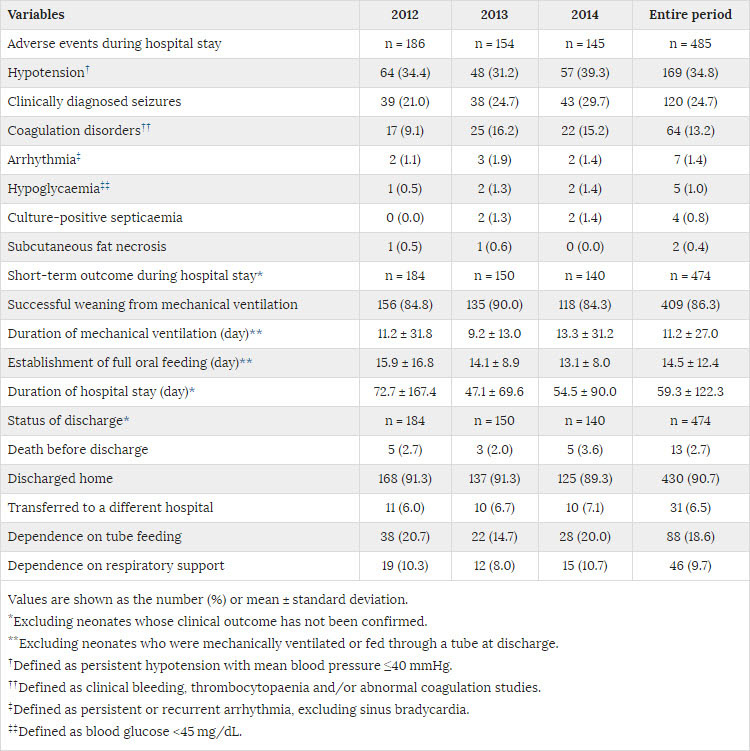新生児脳症に対する低体温療法:日本新生児低体温療法レジストリーからの最初の3年間についての報告
Therapeutic hypothermia for neonatal encephalopathy: a report from the first 3 years of the Baby Cooling Registry of Japan
2017年1月4日 Scientific Reports 7 : 39508 doi: 10.1038/srep39508

低体温療法は、中等度から重度の新生児脳症に推奨されているが、世界的には当初の想定より広い範囲の新生児に適用されるようになってきている。低体温療法の臨床使用状況を調べるために、日本新生児低体温療法登録制度(Baby Cooling Registry of Japan)の最初の3年間(2012~2014年)に収集されたデータを解析した。低体温療法を受けた新生児485人のうち、96.5%が在胎36週以上であり、99.4%が出生体重1,800 g以上であった。68.9%に重度のアシドーシス(pH < 7あるいは塩基欠乏 ≥16 mmol/L)が存在し、96.7%に10分を越える蘇生が必要であった。88.3%にステージII/IIIの脳症があり、その他の症例の多くにおいても、筋緊張低下、けいれん発作、および振幅圧縮脳波(amplitude-integrated enchephalogram: aEEG)上の異常所見が観察され、日本で標準的プロトコルに基づく冷却基準が遵守されていることが確認された。院内死亡率は2.7%であり、90.7%が自宅へ退院した。この研究期間において、冷却症例のアプガースコアやアシドーシスおよび脳症の重症度に年次変化はなかった。目標体温達成までの時間は2012年と比べて2014年で短縮が認められた。この研究期間において、全身冷却を行った症例は45.4%から81.6%に上昇し、選択的頭部冷却を試行した症例は逆に低下した。また、この研究期間における死亡率、人工呼吸管理期間、退院時に経管栄養が必要な児の数に変化は見られなかった。研究期間中、標準的な冷却プロトコルが順守されていたのに加え、冷却導入に要する時間は一貫して短縮傾向を見せた。低体温療法を受けた新生児の死亡率はこれまでの研究での報告よりも非常に低かった。
Corresponding Author
Therapeutic hypothermia is recommended for moderate and severe neonatal encephalopathy, but is being applied to a wider range of neonates than originally envisaged. To examine the clinical use of therapeutic hypothermia, data collected during the first 3 years (2012–2014) of the Baby Cooling Registry of Japan were analysed. Of 485 cooled neonates, 96.5% were ≥36 weeks gestation and 99.4% weighed ≥1,800 g. Severe acidosis (pH < 7 or base deficit ≥16 mmol/L) was present in 68.9%, and 96.7% required resuscitation for >10 min. Stage II/III encephalopathy was evident in 88.3%; hypotonia, seizures and abnormal amplitude-integrated electroencephalogram were observed in the majority of the remainder. In-hospital mortality was 2.7%; 90.7% were discharged home. Apgar scores and severity of acidosis/encephalopathy did not change over time. The time to reach the target temperature was shorter in 2014 than in 2012. The proportion undergoing whole-body cooling rose from 45.4% to 81.6%, while selective head cooling fell over time. Mortality, duration of mechanical ventilation and requirement for tube feeding at discharge remained unchanged. Adherence to standard cooling protocols was high throughout, with a consistent trend towards cooling being achieved more promptly. The mortality rate of cooled neonates was considerably lower than that reported in previous studies.

